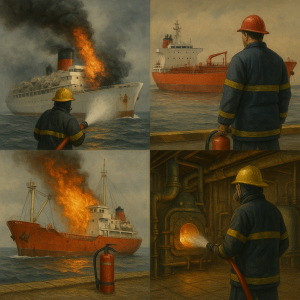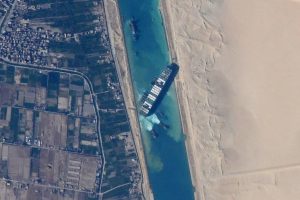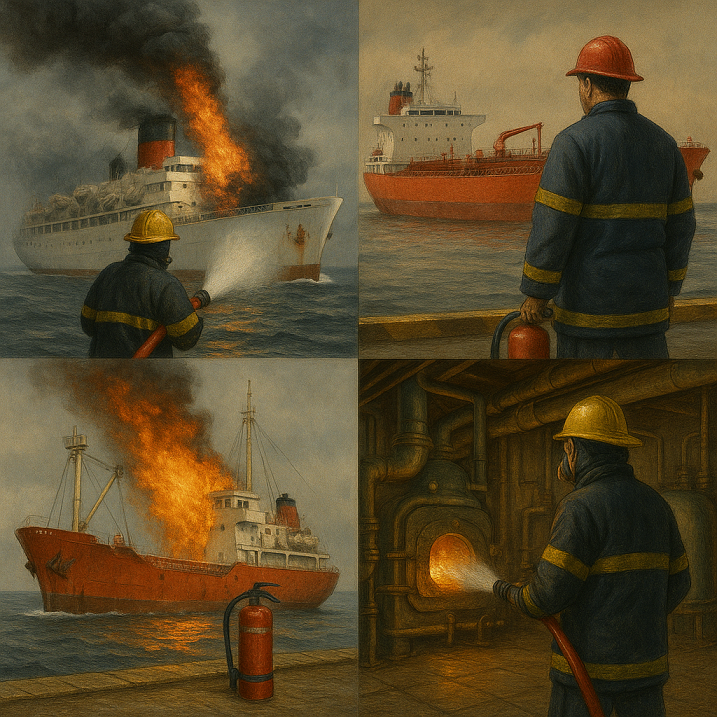Explore fire hazards and safety measures across different types of ships. Learn from real-world incidents, IMO guidelines, and cutting-edge technologies shaping maritime fire prevention.

Why fire safety matters at sea
Fire is one of the most dangerous emergencies that can occur on a ship. It spreads fast, destroys equipment, threatens lives, and compromises the vessel’s structural integrity. Unlike land-based settings, ships are isolated in the middle of the ocean—far from the help of fire brigades. Therefore, robust fire prevention, early detection, and effective suppression are critical for all maritime operations.
According to the European Maritime Safety Agency (EMSA), 10–15% of all shipboard accidents reported between 2014–2023 involved fire or explosion. In confined spaces like engine rooms, cargo holds, or accommodation areas, a small spark can escalate quickly. The International Maritime Organization (IMO) and classification societies such as DNV, Lloyd’s Register, and ABS mandate strict fire safety regulations through SOLAS (Safety of Life at Sea) and the Fire Safety Systems (FSS) Code.
Understanding fire hazards by ship type
Each type of ship carries unique risks due to the nature of the cargo, onboard systems, or structural design. Let’s explore how fire risks vary across ship categories.
Tankers (Oil, Chemical, LNG)
Tankers carry highly flammable liquids or gases. The main fire risks include:
- Vapour cloud ignition
- Static electricity discharge during cargo transfer
- Machinery room oil leaks
Real case: In 2019, a fire broke out aboard the crude tanker Sanchi after colliding with a cargo ship in the East China Sea. The vessel burned for over a week, emphasizing the vulnerability of tankers.
Container Ships
With thousands of containers stacked, it’s difficult to detect and suppress fires early. Misdeclared or improperly packed dangerous goods are often to blame.
Real case: The Maersk Honam tragedy (2018) resulted in five fatalities due to a cargo hold fire, possibly ignited by undeclared chemicals.
Ro-Ro and Passenger Ferries
Vehicle decks often have oil leaks, heated brakes, or faulty electrical systems. Moreover, enclosed car decks create smoke accumulation and hinder evacuation.
Real case: The Norman Atlantic ferry fire (2014) in the Adriatic Sea led to over 30 deaths, showing the complex nature of evacuation and fire control on passenger vessels.
Fishing Vessels
Often older ships with limited fire detection systems. Engine room fires, electrical faults, and onboard fuel storage are key hazards.
Cruise Ships
Modern cruise liners are essentially floating cities. Risks come from kitchens, laundries, entertainment equipment, and high passenger loads.
Case in point: The Star Princess fire (2006) spread across multiple balconies due to flammable plastic furniture, killing one and injuring 11.
Bulk Carriers
Though they carry dry cargo, self-heating bulk like coal or grain can ignite spontaneously, especially in poorly ventilated holds.
Naval and Military Vessels
These ships carry weapons and complex electrical systems. Fires may result from combat damage, internal explosions, or propulsion system failure.
–
Key technologies and developments in maritime fire safety
Over the past two decades, fire detection and suppression technology has evolved rapidly, backed by research and regulation. Some major innovations include:
Integrated fire detection and alarm systems
Modern ships now feature networked detectors—thermal, optical, and gas sensors—connected to a centralized fire control station. These systems allow rapid identification of hot spots.
Water mist systems
Water mist suppresses fire by cooling and displacing oxygen, using less water than traditional sprinklers. This is particularly useful in engine rooms where water damage must be minimized.
Foam fire suppression
Common in tankers and chemical carriers. Foam blankets flammable liquids and prevents vapor release.
Inert gas systems
Used on tankers to fill empty cargo tanks with nitrogen or exhaust gas, reducing the oxygen concentration to prevent ignition.
Fire-fighting robots and drones
DNV and Wärtsilä are testing autonomous drones to inspect fires in hard-to-reach cargo holds, especially on large container ships.
Thermal imaging and IR cameras
Helpful for locating fire sources behind bulkheads or inside machinery. Integrated with bridge and ECR monitoring systems.
Digital training and simulation
Maritime academies and companies like Kongsberg offer VR-based fire drills to simulate real emergencies. This enhances preparedness and reduces training costs.
–
Regulatory frameworks shaping fire safety
The backbone of international fire safety at sea lies in compliance with IMO and flag-state regulations.
SOLAS Chapter II-2
The IMO’s SOLAS Convention is the leading framework for fire protection. Chapter II-2 outlines fire prevention, detection, and extinction requirements.
Fire Safety Systems (FSS) Code
Details the design, testing, and maintenance standards for fire systems on board. It includes requirements for detectors, extinguishers, water mist systems, escape routes, and more.
ISM Code (International Safety Management)
Requires shipping companies to implement a Safety Management System (SMS) that addresses fire safety protocols, drills, and audits.
Classification society rules
Lloyd’s Register, ClassNK, and ABS provide additional fire safety guidelines during ship design approval and annual surveys.
STCW Convention
The Standards of Training, Certification, and Watchkeeping mandate onboard fire-fighting training for all crew under IMO Model Course 1.20.
–
Real-world applications and case studies
The Ever Given fire (2020)
While stuck in the Suez Canal, a small machinery fire broke out. Thanks to swift crew action and well-maintained extinguishers, the fire was controlled quickly, avoiding catastrophic damage.

Credit: https://en.wikipedia.org/wiki/2021_Suez_Canal_obstruction
Wärtsilä’s smart fire prevention system
Wärtsilä’s Smart Marine Ecosystem integrates ship sensors, fire detectors, and engine control systems into a unified platform, capable of initiating automatic shut-offs or alarms.
Viking Life-Saving Equipment
Viking developed modular fire-suits and fire stations that comply with SOLAS but are tailored for individual ship types.
DNV’s research on battery fires
As electric propulsion becomes popular, DNV has studied the fire risk of lithium-ion battery packs aboard hybrid ferries. Their 2023 white paper recommends fire containment boxes and dedicated cooling systems.
–
Challenges and practical limitations
Despite technological progress, challenges remain:
- Crew complacency: Over-reliance on automation can delay manual fire response.
- Maintenance gaps: Fire suppression systems must be regularly tested; many port-state inspections find expired extinguishers or disabled alarms.
- Cargo misdeclaration: Still a major issue. Dangerous goods are often falsely labeled, as in the MSC Flaminia fire (2012).
- Aging fleet: Older ships, especially in fishing or small cargo operations, may lack modern systems.
Future outlook for fire safety at sea
As ships get larger, more complex, and automated, fire risks evolve. The maritime industry must remain vigilant and proactive.
- Smart fire safety: Integration of AI with fire sensors to predict high-risk zones based on equipment heat profiles.
- IMO 2028 Amendments: Expected updates to SOLAS may include mandatory thermal imaging systems for cargo ships above a certain tonnage.
- Green ships: Alternative fuels like ammonia or hydrogen come with new fire and explosion risks—requiring updated fire system designs.
- Crew empowerment: Training remains key. No matter how advanced systems are, human readiness saves lives.
–
FAQ: Fire hazards and ship safety
1. What is the most common cause of fire on ships? Engine room fires, often due to oil leaks and poor maintenance, are the leading cause.
2. Are lithium-ion batteries a serious fire risk on ships? Yes, especially on hybrid ferries and support vessels. They can experience thermal runaway if poorly managed.
3. How do fire detection systems work on modern ships? They use smoke, heat, and flame detectors linked to an alarm panel. Systems are often zoned to identify exact locations.
4. What are the key fire drills required on board? SOLAS mandates monthly fire drills, including equipment usage, evacuation, and response simulation.
5. What happens during a Port State Control (PSC) fire safety inspection? Inspectors check extinguishers, fire pumps, alarms, hydrants, emergency lighting, and crew familiarity with the fire plan.
6. How do Ro-Ro ship fires spread so fast? Tight vehicle decks, poor ventilation, and flammable materials (e.g., tires, fuel) make it difficult to stop a fire once it starts.
7. Can AI really help prevent ship fires? Yes, AI-powered systems can detect abnormal heat patterns or pressure build-ups, offering early warnings beyond human observation.
Conclusion
Fire remains one of the deadliest threats at sea, but it’s also one of the most manageable—if we respect the risks and invest in safety. Whether on a supertanker or a fishing boat, the basics remain the same: prevent, detect, respond. With stronger regulations, smarter systems, and skilled crews, the maritime industry can look forward to a future where fires are rare—and well-controlled when they do occur.
References
- International Maritime Organization (IMO). (2023). SOLAS Consolidated Edition. https://www.imo.org/en
- European Maritime Safety Agency (EMSA). Annual Overview of Marine Casualties and Incidents. https://www.emsa.europa.eu
- DNV. (2023). Battery Safety in Maritime Applications. https://www.dnv.com
- Lloyd’s Register. Fire Safety Guidelines. https://www.lr.org
- Wärtsilä. Smart Marine Ecosystem. https://www.wartsila.com
- The Maritime Executive. (2023). “Ro-Ro Fires and the Need for Stronger Safety Measures”. https://www.maritime-executive.com
- Marine Insight. (2022). “Types of Fires on Ships”. https://www.marineinsight.com
- MAIB Reports. UK Maritime Accident Investigation Branch. https://www.gov.uk/maib-reports
- STCW Convention and IMO Model Courses. https://www.stcw.info


Thanks